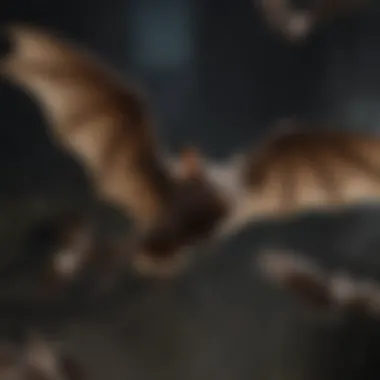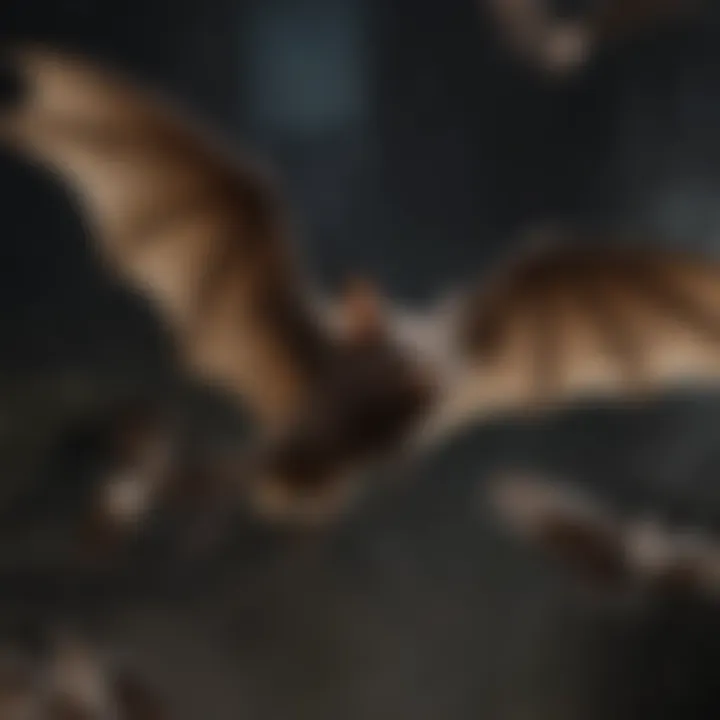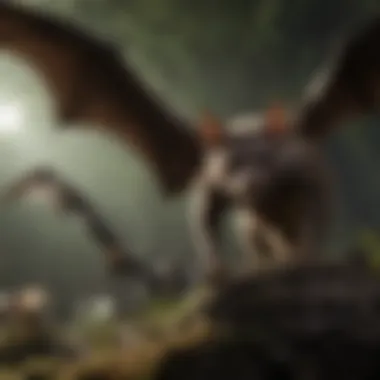Exploring the Diversity of Bat Species and Their Ecological Impact


Overview of the Topic
Bats represent an astounding diversity of life within the natural world. With over 1,400 species worldwide, they inhabit a wide range of ecosystems, from deserts to tropical forests. Not only do bats play crucial roles in their environments, but their unique adaptations and behaviors also make them a fascinating subject of study.
In many cultures, bats are misunderstood creatures. Often associated with gloom or fears stemming from myths, the reality is that these animals contribute positively to our world. In fact, their ecological significance cannot be overstressed.
Key Natural Resource and Environmental Issues
As nocturnal mammals, bats are particularly important for various ecosystem functions. They are known for their prowess in insect control, often consuming vast amounts of pests, thereby helping to maintain crop health and biodiversity. Furthermore, certain species assist in pollination and seed dispersal. These activities underscore their value as natural resources and highlight the ecological balance they help sustain.
Background Information
Bats facilitate critical processes in ecosystems. For instance, fruit bats, feeding primarily on nectar and fruits, are responsible for numerous plants' reproduction. Without these gentle pollinators and seed dispersers, certain plant species—including those that provide food for other wildlife—may decline, leading to potential collapse in the ecosystem.
In reviewing their wide-ranging adaptations, from echolocation to roosting behaviors, it becomes clear that the diversity of bat species is a testament to nature's ingenuity. Understanding this diversity deepens our appreciation of their roles and the importance of their conservation.
Current Status and Challenges
Current State of Bat Populations
The status of bat populations worldwide is alarming. Studies show that many species are in decline, primarily due to human activities. Habitat loss, climate change, and persecution remain the leading causes of this downfall. Disturbingly, white-nose syndrome, a fungal disease, has impacted bat populations in North America, leading to dramatic decreases.
Challenges Facing Bat Species
- Habitat Loss: Urban development and agricultural expansion continually reduce the natural habitats where bats live and forage.
- Climate Change: Alterations in weather patterns disrupt migratory routes and breeding seasons, affecting food availability.
- Pesticide Use: Chemical pesticides can poison bats directly or contribute to the decline of their food sources.
- Disease: The spread of infectious diseases, like white-nose syndrome, continues to threaten already vulnerable populations.
"Conservationists must band together to propagate awareness of bat biology and the challenges they face. A solid understanding lays the groundwork for robust protective measures."
Sustainable Solutions
Sustainable Practices
To combat the numerous challenges facing bats, conservation efforts need to be multifaceted. Here are a few strategies that could make an impact:
- Habitat Restoration: Replanting and preserving natural habitats can help provide safe roosting and feeding areas for bat populations.
- Education and Awareness: Encouraging community education on bats can help dispel myths and foster a willingness to protect these creatures.
- Research: Continued scientific research is vital to understanding bat behavior, migrations, and diseases, assisting in effective management plans.
Examples of Effective Resource Management
In various regions, successful initiatives have emerged. For example, in Texas, landowners are encouraged to maintain bat habitats on their properties through incentives. In Europe, legislation protects certain bat species, ensuring their habitats are preserved during construction projects. These localized efforts highlight the importance of proactive engagement in conservation.
Impact and Importance
Impact on Ecosystems and Communities
Bats are the unsung heroes of many ecosystems. Their roles as insectivores, pollinators, and seed dispersers extend beyond their benefit to plants; they also underpin the food web and affect population dynamics of other species within the ecosystem. A healthy bat population thus contributes to a balanced ecosystem, which supports various forms of life, including our own.
Importance of Conservation
The decline of bat populations signifies broader environmental issues. Protecting bats is about securing biodiversity, ensuring stability in food systems, and sustaining healthy ecosystems for future generations. Understanding the uniqueness of each species only reinforces the urgent need to act.
Simply put, by protecting bats, we are securing a more sustainable future, not only for them but for the entire biosphere.
This holistic approach enhances our understanding of the complex interplay between bats and their environments, and it serves as a clear call for informed conservation actions as we forge ahead in exploring the remarkable diversity of bat species.
Preface to Bat Species
Bats are fascinating creatures that hold a significant place in the natural world. This introduction aims to establish the foundation for understanding their diversity, behaviors, and ecological roles. As one of the only flying mammals, bats exhibit a range of adaptations that enable them to thrive in various environments, from dense tropical forests to arid deserts. Grasping the intricacies of bat species is not merely an academic pursuit; it is crucial for appreciating their impact on ecosystem health and biodiversity.
Defining Bats
Bats belong to the scientific order Chiroptera, meaning "hand-wing." This classification reflects their unique wing structure, where the bones of their hands support the wings. With over 1,400 species globally, bats come in various shapes, sizes, and colors, showcasing a remarkable variety. From the tiny bumblebee bat with a wingspan shorter than a human hand to the impressive flying foxes that can have wingspans exceeding five feet, the world of bats is as diverse as it is captivating.
A defining trait of bats is their nocturnal lifestyle. They are primarily active during the night, relying on echolocation to navigate and find food. This ability is something that sets them apart from many other mammals, giving them a competitive edge in various ecological niches.
Importance in Ecosystems
Bats play crucial roles in ecosystems, acting as both pollinators and pest controllers. Their specific contributions can be categorized into three main areas:
Pollination
Pollination is a standout aspect of bats' ecological importance. Certain species, particularly fruit bats, are integral to the pollination of various plants. They feast on nectar and, in the process, transfer pollen from flower to flower. This not only supports the reproduction of those plants but also underpins many agricultural practices.
Bats like the Mexican long-tongued bat have been observed visiting specific flowers, which have evolved to suit their feeding habits. This unique relationship boosts biodiversity and is essential for crop production. However, the over-reliance on bats for certain crops can create vulnerabilities, especially in regions where bat populations are dwindling.
Seed dispersal
Seed dispersal is another significant function bats provide to the ecosystem. When bats consume fruits, they digest the pulp but not the seeds. As they roam and excrete those seeds miles from their original location, they help propagate various plant species. This method has been particularly effective in areas like rainforests, where diverse plant life thrives.


Seed dispersal is a beneficial characteristic because it contributes to forest regeneration. However, the disadvantage is that if bat populations decline, as they have in numerous areas due to habitat loss and disease, the associated plants may also suffer, leading to further ecological imbalance.
Control of insect populations
Bats are often dubbed the unsung heroes of pest control. They consume vast quantities of insects, including moths, beetles, and mosquitoes. For instance, a single little brown bat can eat more than 1,000 moths in an evening. This consumption plays a crucial role in maintaining the balance of insect populations.
By controlling these populations, bats reduce the need for chemical pesticides, promoting healthier environments. The flip side, however, is the reliance on bats for pest control means that a decline in bat populations could trigger pest outbreaks, which can severely impact agriculture and human health.
In summary, understanding the diverse roles bats play in ecosystems sheds light on their fundamental importance. As we delve deeper into their characteristics and behaviors, we strengthen our awe for these nocturnal navigators and begin to appreciate what we stand to lose if they are not conserved.
Global Bat Diversity
Understanding the global variety of bat species is essential to appreciating their role in ecology. Bats represent a significant percentage of mammalian diversity, with over 1,400 known species spanning different habitats and geographical regions. What sets bats apart in the animal kingdom is not just their number but their enormous impact on ecosystems. They are crucial players in pollination, seed dispersal, and insect population control, all of which contribute to the health and sustainability of the environments they inhabit.
Overview of Species Richness
In looking into bat species richness, we find a rich tapestry of adaptations and behaviors that showcase their evolutionary diversity. Each species thrives in its specific niche, which reflects the complexity of global ecosystems. For instance, some bats are predominantly insectivorous, while others feast on fruits or nectar, revealing a spectrum of dietary needs that allows them to flourish in various settings. The wide array of bat forms has grown due to their unique adaptations to habitats, making this diversity a vital aspect of understanding their ecological roles.
Regions of High Diversity
Examining regions with high bat diversity highlights the varying conditions that support these creatures. Three distinct environments stand out: Tropical Rainforests, Temperate Forests, and Caves and Karst Landscapes. Each provides a unique backdrop for different bat species, further illustrating the importance of habitat conservation.
Tropical Rainforests
Tropical rainforests are nothing short of a golden ticket for bat biodiversity. These lush ecosystems boast a combination of dense vegetation and a complex canopy structure, offering numerous roosting sites and abundant food sources. A striking feature of tropical rainforests is their year-round warmth and moisture, fostering a continuous supply of fruits and insects. This environment supports a vast array of bat species, from the colossal flying foxes that play a significant role in fruit distribution to various smaller bats that help maintain insect populations. However, the challenge lies in the ongoing deforestation and habitat degradation, which pose significant threats to these delicate ecosystems and their bat inhabitants.
Temperate Forests
In contrast to their tropical counterparts, temperate forests provide a different but equally important habitat for bats. Characterized by distinct seasons, these forests emerge as a transitional zone where bats adapt to changing environments. The cyclical nature of flora and fauna offers seasonal food supply that attracts various bat species. One notable aspect is the abundance of insects during warmer months, sufficient to support larger populations. Additionally, many bats in these forests exhibit hibernation behaviors, allowing them to survive the colder months. However, development pressures, such as urbanization, often infringe on these wooded areas, threatening the unique bat species adapted to these seasonal changes.
Caves and Karst Landscapes
Lastly, caves and karst landscapes offer a fascinating realm for bats. These environments, formed through geological processes, serve as natural roosts with stable microclimates that protect bats from the elements. The unique formations in caves provide dark, isolated spaces ideal for breeding and shelter. Many bat species, notably those in the Rhinolophidae family, have adapted to this specific ecology, using echolocation to navigate and hunt in the dark. While caves provide an excellent habitat, they are also susceptible to human disturbance, which can disrupt bat populations and their delicate breeding cycles. Being mindful of human activities in these areas is essential for conservationists aiming to protect these unique communities.
Bats are not merely nocturnal creatures; they are integral components of our ecosystems, maintaining the balance through various ecological roles.
In summary, the diversity found in bat species is directly linked to the varied habitats they occupy. By studying these unique environments, we can better understand how ecological diversity contributes to the overall health of our planet.
Major Bat Families
Fruit Bats (Pteropodidae)
Fruit bats, belonging to the family Pteropodidae, hold an important place in bat diversity. They are primarily frugivorous, meaning their diet consists largely of fruits. This dietary preference positions them as significant agents in seed dispersal, helping maintain the health of various ecosystems. With their keen sense of sight, these bats often forage during daylight hours, unlike many of their nocturnal relatives.
One notable characteristic of fruit bats is their relatively large size compared to other bat families. Their wingspan can extend up to three feet, which is quite impressive for a mammal capable of flight. Pteropodidae species also play a role in pollination. As they visit flowers in search of nectar, they inadvertently assist in fertilizing plants, thus facilitating fruit production.
Insectivorous Bats
Insectivorous bats constitute a diverse group, feeding primarily on insects. These bats display a range of adaptations that enhance their predatory efficiency.
Vespertilionidae
Within the Vespertilionidae family, we find a notable diversity of species, including the common bat and the little brown bat. A key characteristic of this group is their ability to echolocate effectively. This means they can emit sounds that bounce off objects to pinpoint their locations and prey. For instance, the little brown bat is a keen insectivore, known to consume up to 1,000 tiny insects in a single night, showcasing its significant role in controlling insect populations.
This family is commonly chosen as a focus in ecological studies due to their wide distribution and ecological importance. Their echolocation ability is not only fascinating but also provides insights into the evolution of sensory mechanisms among mammals.
"The role of Vespertilionidae in keeping insect populations in check cannot be overstated; it's a natural form of pest control that benefits both agriculture and human health."
Molossidae
The Molossidae family, commonly referred to as free-tailed bats, presents another fascinating aspect of bat diversity. These bats are recognized for their unique tail structure, which extends beyond their tail membrane, giving them an aerodynamic advantage. They are known for their agility and speed in flight, which helps them capture fast-flying insects on the wing.
A particular species of interest is the Brazilian free-tailed bat, famous for its long migratory patterns. These bats not only play a role in insect control but are also noteworthy for their social behavior, often roosting in large colonies. The Molossidae family is particularly advantageous for studies on bat ecology and behavior, as their social structures and foraging habits offer a rich ground for research.
Horseshoe Bats (Rhinolophidae)
Finally, the Rhinolophidae, or horseshoe bats, are distinguished by a peculiar nose structure that resembles a horseshoe shape. This unique feature enhances their echolocation abilities, allowing them to navigate and hunt in dense forest environments. Horseshoe bats are particularly adapted for foraging in dark caves, where they roost in large clusters.
Their presence is crucial for understanding cave ecosystems and their dynamics, making rhinoloids a significant group for conservation considerations. Their role in pest control and pollination makes them indispensable to both ecological and human interests.
By examining these major bat families, we gain a comprehensive view of how bats function within their ecosystems. Each family, with its specific traits and behaviors, plays a vital part in the health of the environment, enriching our understanding of biodiversity.
Adaptations of Bats
Bats have evolved a fascinating set of adaptations that not only distinguish them from other mammals but also enhance their survival in varied environments. Their unique characteristics enable them to occupy ecological niches that few other creatures can fill. These adaptations are crucial in understanding their role in ecosystems, making it imperative to examine how these traits contribute to their success as a diverse group of species.
Echolocation Mechanism


One of the most remarkable adaptations of bats is their ability to echolocate. This natural sonar system allows them to navigate and hunt effectively in complete darkness, which is especially advantageous given their nocturnal lifestyles. Bats emit high-frequency sound waves, and by listening to the echoes that bounce back from objects, they are able to interpret their surroundings with astonishing precision. This ability not only helps them avoid obstacles but also aids in pinpointing the location of prey, such as insects.
Echolocation is far from a simple process. It involves several intricate components:
- Sound Production: Bats produce echolocation calls through their mouths or nostrils. Different species may vary the frequency and duration of these calls to match their hunting needs.
- Listening: Using specialized structures in their ears, bats can detect even the faintest echoes, enabling them to discern the size, distance, and texture of objects.
- Brain Processing: Bats possess highly developed auditory cortices, allowing them to process sound information rapidly and efficiently, making split-second decisions whether to pursue or evade.
This clever adaptation gives bats a competitive edge in their habitats, increasing their efficiency as predators and significantly impacting the populations of insects they control.
Wing Structure and Flight
The wing structure of bats is another key adaptation that has enabled their survival and success. Unlike birds with feathers, bat wings are composed of a highly flexible membrane of skin stretched over elongated finger bones. This unique design grants bats incredible maneuverability and the ability to perform complex aerial acrobatics, setting them apart in the world of flying animals.
Several features of bat wings contribute to their flight prowess:
- Surface Area: The expansive surface area of their wings allows for greater lift, making it easier for them to soar and glide with minimal energy.
- Flexible Joints: The joints in bat wings can maneuver effortlessly, allowing for sharp turns and quick changes in direction when chasing prey or avoiding predators.
- Muscle Strength: Bats have powerful flight muscles that support rapid and sustained flapping, crucial for long distances and swift hunting maneuvers.
These adaptive traits not only help in efficient flight but also in foraging for food, navigating through complex habitats, and avoiding threats.
As a group, bats exhibit an extraordinary range of adaptations that enhance their ability to thrive in diverse environments. Their echolocation and specialized wing structures highlight how evolution has crafted these creatures to dominantly navigate the night sky, making them essential players in our ecosystems.
Behavioral Patterns
Understanding the behavioral patterns of bats provides significant insights into their survival strategies and their role within ecosystems. These patterns encompass a variety of activities, from roosting and social interactions to mating rituals, making them essential for grasping how bats adapt and thrive in diverse environments. Knowing these behaviors can enrich conservation efforts by identifying critical habitat needs and how human activities might disrupt these delicate behaviors.
Roosting Habits
Bats are known for their unique roosting habits, and the type of roost they choose can greatly affect their survival. Most species prefer secluded spots such as caves, tree hollows, or under the eaves of buildings. For instance, the big brown bat often roosts in old barns or attics, taking advantage of the warmth and seclusion these places provide. In contrast, fruit bats typically roost in larger colonies, often in tall trees or forests where their diet is abundant.
- Temperature Regulation: Bats are endothermic creatures. They seek out roosting locations that can help them regulate their body temperature, particularly in changing weather conditions.
- Safety from Predators: Roosting in groups helps reduce predation risks. There’s strength in numbers, and this behavior promotes safety as it allows them to keep watch for potential threats.
- Rearing Young: Maternity colonies are vital for raising pups. Here, mothers can be found roosting shoulder to shoulder, and they tend to leave pups together while they forage for food.
The selection of roosting sites also highlights how anthropogenic changes, like urban development and deforestation, can impact bat populations. Protecting these natural roosts is crucial for their continued existence, and understanding their patterns allows us to advocate effectively for the preservation of their habitats.
Mating and Reproduction
Mating and reproduction in bats are intricate behaviors that are equally fascinating and critical for population sustainability. Many bat species exhibit distinct courtship behaviors, often involving elaborate vocalizations and displays. For instance, male pipistrelle bats may perform aerial acrobatics to attract females. This not only demonstrates their fitness but also helps maintain genetic diversity in the population.
- Breeding Seasons: Bat mating seasons usually align with abundance in food sources, ensuring that nursing mothers have enough sustenance during the gestation and lactation periods.
- Delayed Fertilization: Some species have an unusual reproductive strategy known as delayed fertilization. This means females can store sperm for months, allowing them to synchronize the birth of their pups with optimal environmental conditions.
- Parental Investment: While some species provide minimal postnatal care, others show high levels of maternal investment. For example, many mothers will return to their roosts repeatedly to nurse their young, forming close bonds.
The nuanced strategies bats employ for mating and reproduction highlight their adaptability and resilience, showing that even the smallest creatures can have complex social structures and life cycles.
In summary, both roosting habits and mating behaviors are fundamental in determining bat populations. By understanding these patterns, conservationists and environmentalists can more effectively address the challenges bats face, creating targeted actions that honor their needs and promote their survival.
Conservation Status
Understanding the conservation status of bat species holds paramount importance in the overall discourse surrounding their diversity. Bats are not only instrumental in maintaining ecological balance but also support agricultural practices and contribute to the health of human habitats. Therefore, recognizing the threats they face and taking appropriate measures for their conservation is essential not just for bats themselves but for the ecosystems they support. The subsequent exploration of the threats to bats provides a lens through which we can gauge the urgency of efforts directed towards their preservation.
Threats to Bat Species
Habitat Loss
Habitat loss is a significant issue threatening bat populations around the world. One prominent factor contributing to habitat degradation is urban expansion. As cities grow, natural landscapes are replaced with concrete jungles, leaving bats with fewer places to roost and forage. This phenomenon disrupts their feeding and reproduction patterns. Urbanization not only reduces the available habitats but also fragments the existing ones, making it difficult for bats to establish stable populations.
Key characteristic of habitat loss is its widespread nature, affecting bats across diverse regions. This makes it a pertinent topic for conservation discussions. The unique feature of habitat loss is its potential to lead to species extinction if not addressed. This situation undeniably presents disadvantages for bats and ecosystems at large.
Climate Change
Climate change stands as another formidable threat to bat species. Temperature fluctuations and changing weather patterns affect insects, the primary food source for many bats. With insects also being sensitive to such changes, their populations may dwindle, resulting in food scarcity for bats. Additionally, alterations in temperature and precipitation can disrupt the natural habitats that bats rely on for roosting.
A key characteristic of climate change is its gradual nature versus the immediacy needed for effective conservation. The complexity of climate predictions adds to the challenge, making it a beneficial choice for discussing proactive measures in bat conservation. One unique feature of this threat is the interplay between global changes and local consequences; while the cause is expansive, its effects can be quite localized, either beneficial or detrimental.
Human Disturbance
Human disturbance significantly impacts bat populations, too. Activities such as caving, mining, and disturbances in roosting areas can lead to displacement and increased vulnerability for bats. The noise and light pollution resulting from these activities can further disrupt their natural behaviors.
The key characteristic of human disturbance is its direct correlation with human activities, making it a pertinent topic for conservation efforts focused on awareness. This issue is unique as it speaks to the very intersection of human existence and wildlife, underlining how human choices can lead to dire consequences for bat species. The disadvantage is clear: while humans seek enjoyment or resources, bats suffer the consequences that may ultimately threaten their survival.
Conservation Efforts
Conservation efforts aimed at protecting bat populations take various forms, each crucial to ensuring their survival. By implementing strategic measures, we can effectively counteract the threats facing these creatures.
Protected Areas
Creating protected areas is one of the most effective means of securing habitats for bats. These areas serve as sanctuaries where bats can thrive away from human interference. They not only promote biodiversity but also facilitate research and education on these intriguing creatures. The importance of protected areas lies in their structured conservation approach, safeguarding ecosystems that are essential for bats.
A unique feature of protected areas is the potential for ecological corridors. These corridors allow for movement between habitats, which is vital for maintaining genetic diversity within bat populations. However, the disadvantage is that establishing and maintaining these areas often requires significant resources and long-term commitment.
Legislative Measures


Legislative measures are another necessary avenue for successful conservation. Laws and regulations targeting habitat protection, pollution control, and anti-poaching efforts can create a formidable framework for safeguarding bat populations. The key characteristic of these measures is their capacity to create a legal obligation for conservation, providing a structure within which efforts can be coordinated.
A distinctive feature of legislative action is its potential to inspire public participation and accountability. Laws can empower communities, but in certain cases, creating legislation can be a slow and complex process, often facing opposition from various stakeholders.
Public Awareness Initiatives
Public awareness initiatives play a crucial role in bat conservation as well. Educating the public about the ecological importance of bats and the challenges they face can foster community support for conservation efforts. Such initiatives contribute to shifting perceptions, instilling a sense of responsibility towards wildlife. The key characteristic of this approach is its accessibility, reaching out to diverse audiences.
One unique feature is the ability for these initiatives to utilize social media platforms and community gatherings effectively. Awareness activities can build community engagement but can sometimes struggle to maintain sustained interest and commitment over time.
Role of Bats in Human Context
Bats might be cruising through the night sky, but their importance to humans and ecosystems is a topic that deserves the spotlight. While many folks might regard them as mere creatures of the darkness, bats offer nuanced benefits that cradle both culture and economy. Understanding their roles can make a meaningful difference on multiple fronts, helping to resonate with the idea that these flying mammals are more than meets the eye.
Cultural Significance
Myths and Folklore
Bats have wiggled their way into the fabric of various myths and folklore across cultures. In places like China, they symbolize good fortune, while in Western traditions, they oftentimes take on a more sinister backdrop. This duality, from harbingers of good luck to creatures associated with darkness, adds layers to our understanding of humanity's relationship with these animals. The value here lies in how such stories reflect human fascination and fear alike—not to mention how they impact conservation initiatives today.
Many believe that fostering appreciation through storytelling can lead to more robust conservation efforts. When people connect emotionally to an animal through its folklore, they are more likely to support measures aiming to protect those species. Therefore, the myth-making surrounding bats isn't just interesting; it's an essential thread in the vast tapestry of conservation.
Representation in Art and Literature
The representation of bats in art and literature provides another compelling lens through which we can explore their significance. Artists often use bat imagery to convey themes of mystery or otherness, which can enrich interpretations within various art forms. Notably, literary figures like Edgar Allan Poe featured bats to evoke eerie, gothic tones that have woven bats into the popular imagination. This serves as a beautiful reminder that art reflects society's relationship with nature.
Bats, as symbolic figures, can enhance dialogue about environmental issues. When people see or read about them in a relatable context—be it a haunting poem or a captivating sculpture—they are provided with a unique opportunity to engage in discussions about ecological balance. Thus, their representation isn't merely a decorative choice; it is a deeply significant one.
Economic Impact
Pollination Services
Bats play a crucial role in pollination, helping to fertilize plants that produce everything from avocados to agave. This natural service is particularly valuable to our agriculture and economy, as many crops depend on these nocturnal creatures for reproduction. For instance, the agave plant, used to make tequila, benefits significantly from bat pollination, highlighting the interconnectedness of ecosystems and economy.
Pollination can directly impact food production, as a decline in bat populations could result in a notable reduction of certain crop yields. In places where human activity encroaches on bat habitats, the economic consequences might ripple through local markets. Hence, there's a compelling reason for agricultural stakeholders to advocate for bat conservation.
Biological Pest Control
Bats also act as natural pest controllers, feasting on insects such as mosquitoes and agricultural pests. Studies reveal that a single bat can consume thousands of insects in one night, greatly aiding fields and gardens in maintaining balance. By using bats for pest control, farmers could potentially reduce reliance on chemical pesticides, fostering a more sustainable farming practice.
This economic benefit not only lays the groundwork for healthier ecosystems but also contributes to lower costs for farmers in the long run. The synergy between bats and agriculture paints a vivid picture of how bat preservation is directly linked to economic viability for many communities.
"If we want to protect our crops and livelihoods, we must first protect the bats that protect them."
Ultimately, bats serve a dual purpose—they enrich our cultural stories and provide critical economic services. As such, recognizing their importance could help us work toward brighter outcomes not just for bat species, but for humans as well.
Future Directions in Bat Research
As we turn our gaze toward the horizon of bat conservation and understanding, it becomes clear that future research is not just a luxury, but a necessity. Studying bat species is essential for grasping their complex roles in ecosystems, especially as they face unprecedented changes due to human activity and climate shifts. Continued research will help pinpoint strategies that not only safeguard these mammals, but also enhance our understanding of biodiversity as a whole.
Advancements in Technology
The integration of technology has transformed the landscape of bat research profoundly. Acoustic monitoring, for instance, allows scientists to record and identify bat calls with high precision. This method is invaluable for surveying bat populations in various ecosystems without physically disturbing them. More advanced techniques, like drone technology, can be utilized for assessing habitats over larger areas, providing data on bat activity in real-time.
Additionally, genomic sequencing is opening up pathways to understanding bat physiology and adaptations, which is crucial for developing targeted conservation strategies. By mapping the genomes of different bat species, researchers can uncover traits that enable resilience against diseases or climate shifts.
"With these tools at our disposal, the ability to gather and analyze data is evolving rapidly, leading us to a future where informed decisions can be made faster and more effectively."
Collaborative Conservation Initiatives
To truly turn the tide for bats, it requires a collaborative approach where researchers, conservationists, and local communities come together. Projects that involve community-based conservation not only engage the public in protecting local bat habitats but also educate them about the species' roles in their ecosystems. This grassroots involvement often leads to better outcomes, as local knowledge and commitment are essential in the conservation dialogue.
International collaborations can maximize conservation efforts. By pooling resources, sharing research, and creating common goals, nations can address the challenges faced by migratory bat species that traverse borders. Notable initiatives like the Global Bat Conservation Network exemplify how partnerships can facilitate knowledge exchange and funding opportunities, leading to impactful research and the implementation of best practices within diverse regions.
Understanding the future directions in bat research allows us to appreciate the significance of these creatures more fully. It emphasizes a need for ongoing investment in technology and collaboration to ensure bats are around for generations to come.
End
As we wrap up our exploration of bat diversity, it’s vital to reflect on the threads woven throughout this intricate tapestry. Bats, often underestimated or misunderstood, play an indispensable part in the web of life. They contribute significantly to pest control, pollination, and the dispersal of seeds, thus influencing ecosystem dynamics. Recognizing their ecological importance enhances our understanding of natural processes and biodiversity.
Summarizing Key Insights
In our journey through this article, several key insights emerge:
- Ecological Significance: Bats are not just creatures of the night; they are vital pollinators and pest controllers, which ensures a balanced ecosystem.
- Diversity: With over 1,400 species, the range among bats is astonishing, from the tiny bumblebee bat to the majestic flying fox. Each species plays a unique role tailored to its habitat.
- Adaptations: Their ability to echolocate and their specialized wing structures are marvels of evolution, allowing them to thrive in various environments.
- Threats and Conservation: Habitat loss, climate change, and human interference pose significant threats to bat populations. Conservation efforts are critical in mitigating these challenges.
This detailed overview emphasizes that understanding bats goes beyond mere observation; it requires an appreciation of their roles and the challenges they face.
Call to Action for Conservation
Now, more than ever, it's essential to act decisively in favor of bat conservation. Here are a few considerations:
- Support Local Initiatives: Engage with local conservation groups focused on bat habitats and awareness programs. Often, grassroots movements lead to impactful change.
- Educate Others: Share insights about bats in your community, dispelling myths and promoting understanding. Education is a powerful tool in wildlife conservation.
- Advocate for Policies: Push for legislation that protects bat habitats and wildlife corridors. Policy changes can have far-reaching effects on conservation efforts.
- Participate in Citizen Science: Join initiatives that monitor bat populations and habitats. Your involvement can provide valuable data for researchers working in the field.
By collectively acting to conserve bats, we contribute to the health of our planet's ecosystems, ensuring that these remarkable creatures continue to thrive for generations to come.



